Southern Wisconsin Paranormal Research Group
©Dave Schumacher, Cindy Heinen – All Rights Reserved
Director’s Brief:
Research compilations for ambient magnetic conditions and psi functioning provided by S. James P. Spottiswoode (2) suggest a negative correlation: “Retrospective analyses of putative spontaneous psi, or anomalous cognition (AC), events have shown a tendency for these to be reported on days of relatively low geomagnetic disturbance.” jsasoc.com/library.html
Haunting events and EVP are believed to be a psi function, but nevertheless, there has been no research reported that supports the view that EVP is influenced by the magnetic environment The following research report details an effort to determine if there is a detectable correlation.
Introduction
Those who believe EVP to be real think that the voices of the dead are being recorded while those who do not believe in the paranormal nature of these phenomena claim that they are nothing more than stray radio waves or auditory pareidolia or apophenia. It is a proven fact that the human mind can create meaning out of insignificant sound and random noise. Those who support the paranormal nature of this phenomena claim that the voices are interactive and can be identified as someone who has died. The question then, is how do the deceased manifest their voices on the recording equipment?
Some EVP researchers, ghost hunters and paranormal investigators believe that entities use physical sound energy and re-modulate it to form words. In addition, there is anecdotal evidence that:
- More messages are recorded at night or during stormy weather than during the day or when the weather is clear,
- There is a relationship between EVP and electrical or moisture conditions of the atmosphere,
- Other types of energy, such as light and magnetism, can influence EVP recordings (1).
The ghost hunting community overall believes that times of increased solar activity are ideal for ghost hunting. It is thought that, with enough energy in the air from charged ions and an energized electromagnetic field, manifestations, including EVP, are more plentiful and clear (9, 10). This belief is due to investigator’s personal experiences and the extrapolation and interpretation of the published scientific literature.
There are published studies in peer reviewed academic journals and books that describe a correlation between paranormal activity and geomagnetic fields (3, 8). Some studies have shown there is an increase in poltergeist (Recurrent Spontaneous Psychokinesis or RSPK) events when there is an increase in the geomagnetic field (3, 6), while others found a correlation between an increase in the geomagnetic field and an increase in haunt phenomena, postmortem apparitions, and sensed presences (5, 8). The interpretation of these correlations is open to debate. Some think that the increase in geomagnetic activity either triggers and/or fuels the activity (especially in the RSPK studies) while others feel that the changes in geomagnetic fields and complex electromagnetic fields can induce hallucinations.
There is little or no formal analysis that increased geomagnetic activity leads to an increase in the frequency and clarity of EVP. This study is an attempt to determine if there is a correlation between geomagnetic activity and the quantity of EVP.
Methods
EVP: EVP from 2001 to 2005 were obtained from the Southern Wisconsin Paranormal Research Group case files, the South Jersey Ghost Research Group and the personal files of Cindy Heinen. The number of EVP recorded on each day were tabulated in an Excel spreadsheet. Both days with EVP recorded and days where recording for EVP was attempted but there were no EVP recorded were included.
Geomagnetic Activity
Magnetic field variation can come from currents caused by solar radiation changes. Solarwinds can interact with the magnetosphere. The magnetosphere and ionosphere can cause magnetic field changes by themselves. Magnetic activity indices provided by National Oceanic and Atmospheric Association (NOAA) are used to describe the variation in the geomagnetic field (13).
The a-index is a 3-hourly “equivalent amplitude” index of the local geomagnetic activity; “a” is related to the 3-hourly K-index.
The A-index is the daily index of geomagnetic activity derived as the average of the eight 3-hourly a-indices.
The Ap-index is an average planetary A-index based on data from a set of specific stations (11). The estimated planetary A-index from NOAA (12) was used for this study.
A-index values (24-hrs) of the following determine the geomagnetic conditions:
0 to 7 “Quiet” geomagnetic conditions
8 to 15 “Unsettled” geomagnetic conditions
16 to 24 “Active” geomagnetic conditions
25 to 35 “Minor storm”
36+ “Major storm”
Statistical Analysis
To determine if there was a correlation between the number of EVP recorded and the estimated Ap-index, the number of EVP vs. the estimated Ap-index was plotted and a nonparametric correlation Spearman r analysis was performed using GraphPad InStat version 3.05 for Windows 95/NT, GraphPad Software, San Diego California USA, www.graphpad.com
To determine if there was a difference in the mean estimated Ap-index for when EVP were recorded vs. when no EVP were recorded, a nonparametric Mann-Whitney t-test was performed using GraphPad InStat.
Finally, to determine if a certain level of enhanced geomagnetic activity leads to more EVP, the mean number of EVP was compared for the following:
Ap-index of 0 to 7 “Quiet” vs. 8 to 15 “Unsettled”
Ap-index of 0 to 7 “Quiet” vs. 16 to 24 “Active”
Ap-index of 0 to 7 “Quiet” vs. 25 to 35 “Minor Storm”
Ap-index of 0 to 7 “Quiet” vs. 36+ “Major Storm”
The analysis for each was done with a nonparametric Mann-Whitney t-test using GraphPad InStat.
Results
Two hundred and ten data points were collected and spanned the time period of January 6th, 2001 to August 27th, 2005. There were 101 days with EVP and 109 days without EVP. The number of data points for each estimated Ap-index range/geomagnetic condition were: 0 to 7/“Quiet” = 61; 8 to 15/”Unsettled” = 82; 16 to 24/”Active” = 39; 25 to 35/”Minor Storm” = 18; 36+/”Major Storm” = 10.
0 to 7/“Quiet” = 61
8 to 15/”Unsettled” = 82
16 to 24/”Active” = 39
25 to 35/”Minor Storm” = 18
36+/”Major Storm” = 10.
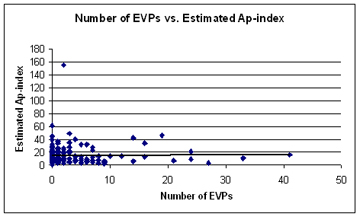
Figure 1 shows the number of EVP plotted against the estimated Ap-index. Spearman r = 0.02882 (95% CI –0.110 to 0.1675; P=0.6779; not significant). r = 0.02882, 95% CI –0.110 to 0.1675; P=0.6779; not significant
| Comparison |
P-value |
Significance |
| Estimated Ap-index when no EVPs were recorded vs. estimated
Ap-index when EVPs were recorded |
0.4477 |
Not significant |
| Mean number of EVPs for “Quiet” vs “Unsettled” |
0.5571 |
Not significant |
Mean number of EVPs for “Quiet” vs “Active”
|
0.9546 |
Not significant |
| Mean number of EVPs for “Quiet” vs “Minor Storm” |
0.7120 |
Not significant |
| Mean number of EVPs for “Quiet” vs “Major Storm” |
0.4319 |
Not significant |
Table 1 shows the results of the statistical analysis for the various comparisons.
Discussion
There is a general belief among the hauntings investigation community that an increase in the geomagnetic field enables paranormal manifestations to be more plentiful and clear. It has been speculated that this extends to EVP as well (9, 10). These beliefs are based on investigator’s personal experiences and conclusions they draw from reading the published scientific literature. There is little if any formal analysis indicating that increases in geomagnetic activity leads to an increase in the number of EVP. This study explored the possibility that increases in the geomagnetic field (as measured with the estimated Ap-index) would lead to an increase in the quantity of EVP.
There was no significant correlation found between the estimated Ap-index and the number of EVP. In addition, there was no significant difference in the mean number of EVP recorded during “Quiet” geomagnetic conditions vs. the mean number of EVP recorded during “Unsettled”, “Active”, “Minor Storm”, or “Major Storm” geomagnetic conditions.
This study has several limitations:
First, the EVP data was collected from three different sources. Since identifying an EVP is highly subjective, different people may classify different things as EVP.
Second, the number of EVP data points became very small when analyzing the different geomagnetic conditions. For example, there were only ten data points in the 36+/”Major Storm” geomagnetic condition. This can limit the statistical power to determine a significant difference.
Third, this study does not address the issue of whether or not EVP have more clarity with elevated geomagnetic conditions. EVP classifications are extremely subjective and were not available in the data sets used in this analysis. This issue needs to be studied in a similar manner.
Fourth, this is only one study based on three data sets from three different sources. It should be repeated with more data sets. It would also be interesting to look at other parameters besides the estimated Ap-index. Formal analysis of various atmospheric conditions would also be interesting.
Conclusion
Despite the limitations, this study has shown that there doesn’t appear to be any correlation between geomagnetic conditions and the number of EVP recorded. However, more studies will need to be done looking at various other factors to see if any other environmental conditions can affect the quantity and quality of EVP.
References
- Butler, T. “ATransC White Paper on Transcommunication.” Association TransCommunication. Revised 9-2020. atransc.org/itc-white-paper/
- Spottiswoode, S. James P. “Apparent Association Between Effect Size in Free Response Anomalous Cognition Experiments and Local Sidereal Time.” The Journal of Scientific Exploration. Society for Scientific Exploration. 1997. jsasoc.com/docs/JSE-LST.pdf
- Roll, W.G. and Gearhart, L. (1974). Geomagnetic perturbations and RSPK. In W.G. Roll, R.L. Morris and J. Morris (Eds.), Research in parapsychology, 1973 (pp.44-46). Metuchen, NJ : Scarecrow.
- Gearhart, L. and Persinger, M.A. (1986). Geophysical variables and behavior: XXXIII. Onsets of historical and contemporary poltergeists episodes occurred with sudden increases in geomagnetic activity. Perceptual and Motor Skills, 62, pp.463-466.
- Persinger, M.A. and Koren, S.A. (2001). Predicting the characteristics of haunt phenomena from geomagnetic factors and brain sensitivity: Evidence from field and experimental studies. In J. Houran and R. Lange (Eds.), Hauntings and poltergeists: Multidisciplinary perspectives, (pp.179-194). Jefferson, NC: McFarland and Company, Inc.
- Roll, W.G. and Persinger, M.A. (2001). Investigations of poltergeists and haunts: A review and interpretation. In J. Houran and R. Lange (Eds.), Hauntings and poltergeists: Multidisciplinary perspectives, (pp.123-163). Jefferson, NC: McFarland and Company, Inc.
- Persinger, M.A. and Richards, P.M. (1995). Vestibular experiences of humans during brief periods of partial sensory deprivation are enhanced when daily geomagnetic activity exceeds 15-20nT. Neuroscience Letters, 194, pp.69-72.
- Persinger, M.A. (1988). Increased geomagnetic activity and the occurrence of bereavement hallucinations: Evidence for melatonin-mediated microseizuring in the temporal lobe? Neuroscience Letters, 88, pp.271-274.
- Chaney, S. (2006). I’ll give you the sun and moon… TAPS Paramagazine, Vol. 1, No. 6, pp.13-14.
- Farrell, M. (2005). The astronomy of ghost hunting. Ghost! Issue 2, pp.70.
- NOAA Glossary: http://www.sec.noaa.gov/info/glossary.html
- NOAA: http://ftp2.sec.noaa.gov/alerts/solar_indices.html
- NOAA Geomagnetic Kp and Ap Indices: noaa.gov/stp/GEOMAG/kp_ap.html

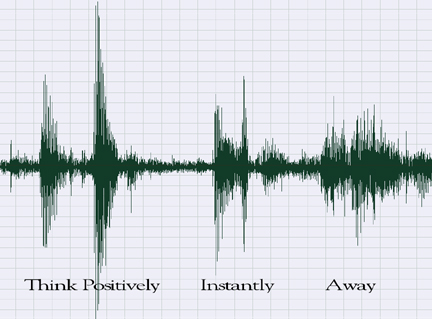
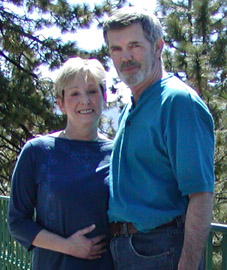
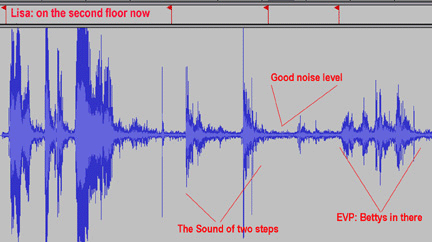
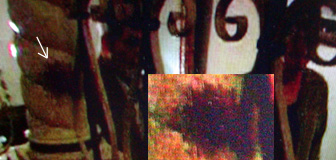
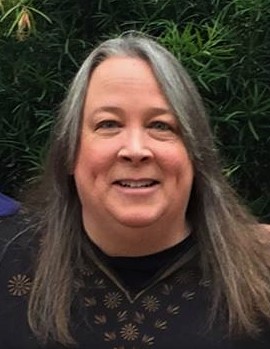


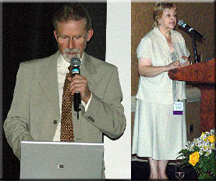

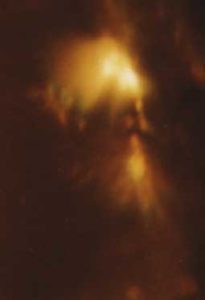
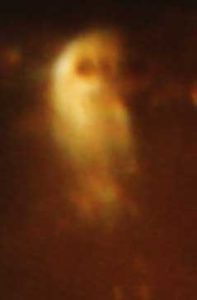

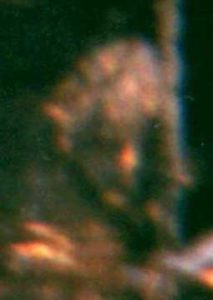

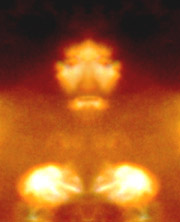
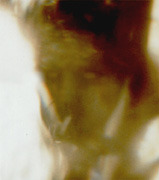

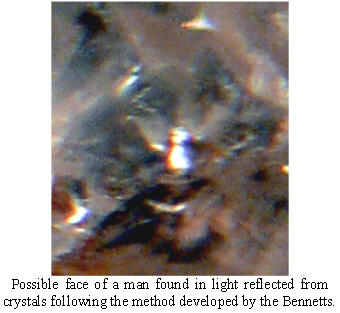
 We have been so inspired by the amazing results of Diane and Alan Bennett, and their results from reflecting light off of crystals, that we had been wanting to also try experimenting in this way. Diana and Alan had been kind enough to provide a couple of diagrams of their experimental setups, and we now had a higher resolution camera, so set up an area in the ITC room to run a couple of crystal experiments. After arranging the camera, lights and crystal in a configuration we felt would work, we did our normal meditation and then took a few pictures. We actually recorded some interesting results on our first attempts. The fourth experiment brought several more faces along with this interesting three-dimensional face. We were very pleased with the open mouth, as the mouth is often obscured in many of our pictures.
We have been so inspired by the amazing results of Diane and Alan Bennett, and their results from reflecting light off of crystals, that we had been wanting to also try experimenting in this way. Diana and Alan had been kind enough to provide a couple of diagrams of their experimental setups, and we now had a higher resolution camera, so set up an area in the ITC room to run a couple of crystal experiments. After arranging the camera, lights and crystal in a configuration we felt would work, we did our normal meditation and then took a few pictures. We actually recorded some interesting results on our first attempts. The fourth experiment brought several more faces along with this interesting three-dimensional face. We were very pleased with the open mouth, as the mouth is often obscured in many of our pictures.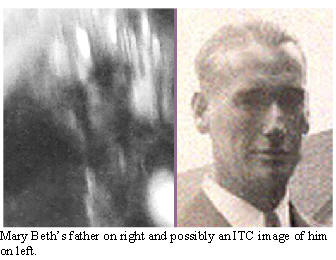 Our next success with the crystal experiments was quite a surprise. We met with a small group every Sunday morning for an hour of meditation. After our meditation, one of the members, Mary Beth, handed Lisa a picture of her parents and ask us to keep a lookout for them in our experiments. Lisa asked her to write the names of her parents on the back of the picture and then put it on her desk when we returned home. That afternoon we did another meditation on our own and conducted a few EVP experiments to test various settings on the two recorders we would be using at a video session for a shoot with the Sci Fi channel. We also worked with reflecting light off a couple of different crystals. When we looked at the results, the image of a man was clearly seen on the very first picture. The resemblance between the ITC picture and Mary Beth’s dad was noted with surprise. It was like he had heard her and stopped by during our experiment to make sure she got an ITC picture of him.
Our next success with the crystal experiments was quite a surprise. We met with a small group every Sunday morning for an hour of meditation. After our meditation, one of the members, Mary Beth, handed Lisa a picture of her parents and ask us to keep a lookout for them in our experiments. Lisa asked her to write the names of her parents on the back of the picture and then put it on her desk when we returned home. That afternoon we did another meditation on our own and conducted a few EVP experiments to test various settings on the two recorders we would be using at a video session for a shoot with the Sci Fi channel. We also worked with reflecting light off a couple of different crystals. When we looked at the results, the image of a man was clearly seen on the very first picture. The resemblance between the ITC picture and Mary Beth’s dad was noted with surprise. It was like he had heard her and stopped by during our experiment to make sure she got an ITC picture of him.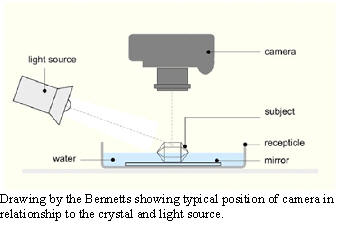 Mary Beth felt that it was her father. We were so surprised with his answering her request so quickly that we wondered if he had been a powerful medium or something, but she explained that she had never known her father. He had left her mother before she was born. He had crossed over many years ago and they had never met. Mary Beth also told us that she had received a message from a medium at a Spiritualist church who had asked her who Franklin was (this was her father’s middle name). The medium told her that Franklin was saying that he was sorry that he had not been part of her life. We were honored that the picture was so meaningful to Mary Beth and we also felt that the positive result was also due to the wonderful positive energy of our meditation group.
Mary Beth felt that it was her father. We were so surprised with his answering her request so quickly that we wondered if he had been a powerful medium or something, but she explained that she had never known her father. He had left her mother before she was born. He had crossed over many years ago and they had never met. Mary Beth also told us that she had received a message from a medium at a Spiritualist church who had asked her who Franklin was (this was her father’s middle name). The medium told her that Franklin was saying that he was sorry that he had not been part of her life. We were honored that the picture was so meaningful to Mary Beth and we also felt that the positive result was also due to the wonderful positive energy of our meditation group.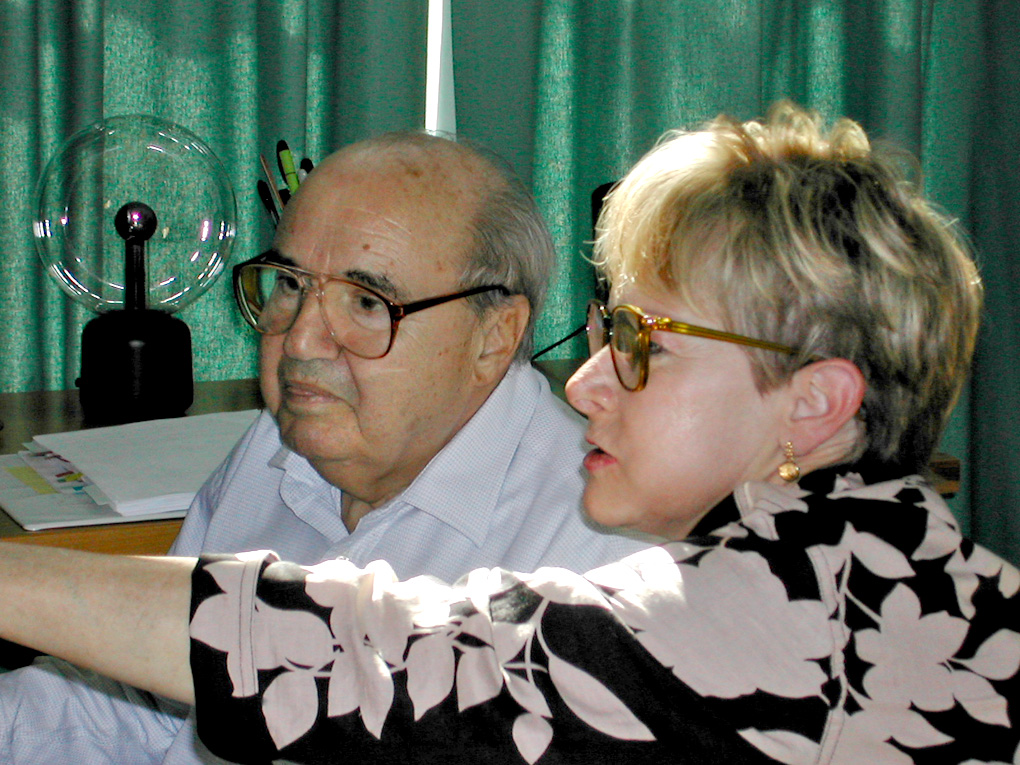
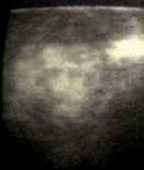 Please note: Phyllis worked with Paulo Cabral between 1998 and 2007 when Paulo made his transition. The Video loopback pictures below were recorded by them.
Please note: Phyllis worked with Paulo Cabral between 1998 and 2007 when Paulo made his transition. The Video loopback pictures below were recorded by them.
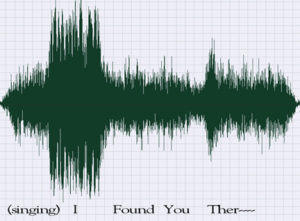


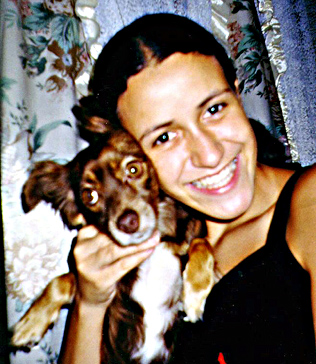
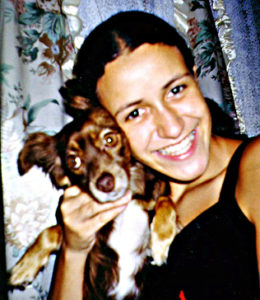

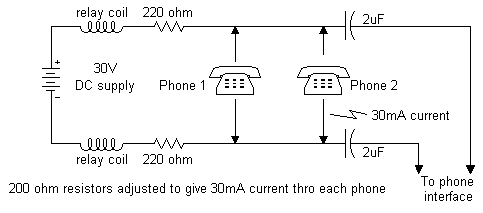
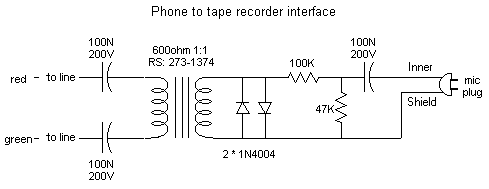 The above device permits the connection of a household phone (and phone line) to a tape recorder or computer soundcard for EVP voice recording purposes.
The above device permits the connection of a household phone (and phone line) to a tape recorder or computer soundcard for EVP voice recording purposes.